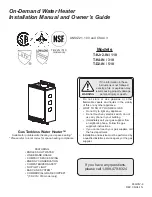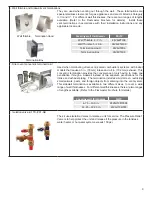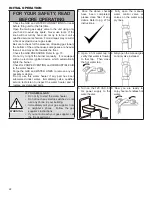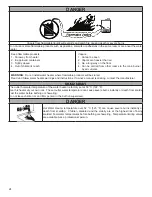
10
High-altitude Installations
Check the elevation where your water heater is installed .
Set DIP switches shown in the table below depending on
the altitude .
T-KJr2-IN / 110 & T-K4-IN / 310 Models
Altitude 0 to 2,000 ft
(DEFAULT)
2,001 to
4,000 ft
4,001 to
6,000 ft
Switch
No . 3
OFF
ON
OFF
Switch
No . 4
OFF
OFF
ON
ON
8
7
6
5
4
3
2
1
ON
8
7
6
5
4
3
2
1
ON
8
7
6
5
4
3
2
1
T-D2-IN / 510 Model
(Left bank of DIP switches)
Altitude 0 to 2,000 ft
(DEFAULT)
2,001 to
4,000 ft
4,001 to
6,000 ft
Switch
No . 4
OFF
ON
OFF
Switch
No . 5
OFF
OFF
ON
ON
6
5
4
3
2
1
ON
6
5
4
3
2
1
ON
6
5
4
3
2
1
•
The dark squares indicate the direction the DIP switches
should be set to .
•
The maximum certified or allowable installed altitude
is 6,000 ft.
T-KJr2-IN / 110 & T-K4-IN
/ 310 Computer board
DIP switches
T-D2-IN / 510
Computer board
DIP switches (Left bank)
WARNING
DO NOT adjust any DIP switches on the right
bank for the T-D2-IN / 510 model .
Venting Instructions
General
DANGER
•
Improper venting of this appliance can
result in excessive levels of carbon
monoxide which can result in severe
personal injury or death .
•
Improper installation can cause nausea
or asphyxiation, severe injury or death
from carbon monoxide and flue gases
poisoning . Improper installation will void
product warranty .
CAUTION
When installing the vent system, all applicable
national and local codes must be followed .
If you install thimbles, fire stops or other
protective devices and they penetrate any
combustible or noncombustible construction,
be sure to follow all applicable national and
local codes .
The water heater must be vented in accordance with the
section “Venting of Equipment" of the latest edition of
CSA
B149.1 Natural Gas and propane Installation Code
as
well as applicable local building codes .
The manufacturer
recommends the Flexmaster line.
However, the following are also UL listed manufacturers:
ProTech Systems Inc . (FasNSeal), Metal-Fab Inc ., and
Heat-Fab Inc . (Saf-T Vent) .
General rules for venting water heaters are:
•
Place the water heater as close as possible to the vent
termination .
•
The vent collar of the water heater must be fastened
directly to an unobstructed vent pipe .
•
Do not weld the vent pipe to the water heater’s vent
collar .
•
Do not cut the vent collar of the water heater .
•
The vent must be easily removable from the top of the
water heater for normal service and inspection of the
unit .
•
Avoid using an oversized vent pipe or using extremely
long runs of the pipe .
•
For rooftop venting, a rain cap or other form of termination
that prevents rain water from entering into the water
heater must be installed .
•
Do not common vent or connect any vent from other
appliances to the water heater vent .
General rules for vent terminations:
•
Avoid locating the water heater vent termination near any
air intake devices . These fans can pick up the exhaust
flue products from the water heater and return them to
the building . This can create a health hazard .
•
Locate the vent termination so that it cannot be blocked
by any debris, at any time . Most codes require that the
termination be at least 305 mm (12 in .) above grade, we
recommend that it be at least 305 mm (12 in .) above the
anticipated snow line, but the installer may determine
that it should be higher, depending on the job site
condition and applicable local codes .
•
A proper sidewall termination is recommended when the
water heater is vented through a sidewall .
•
Regarding the clearances from the exhaust termination
to the air inlet or opening, refer to the next few pages .

























